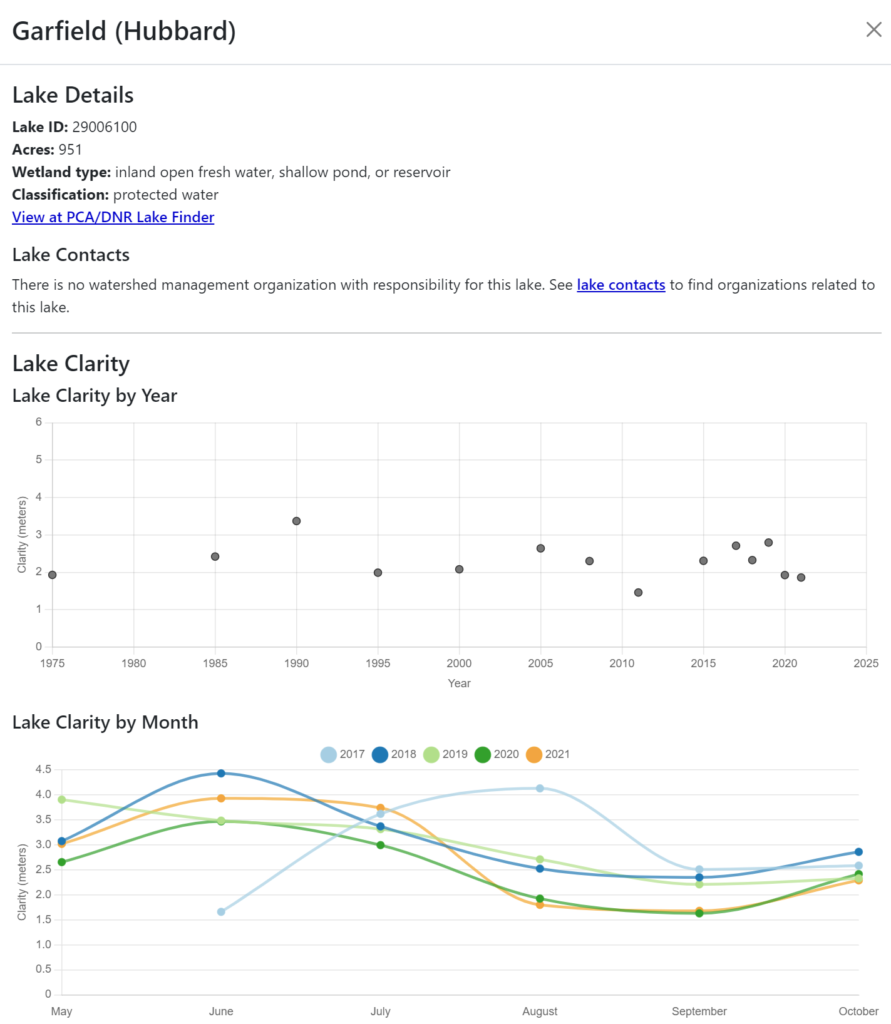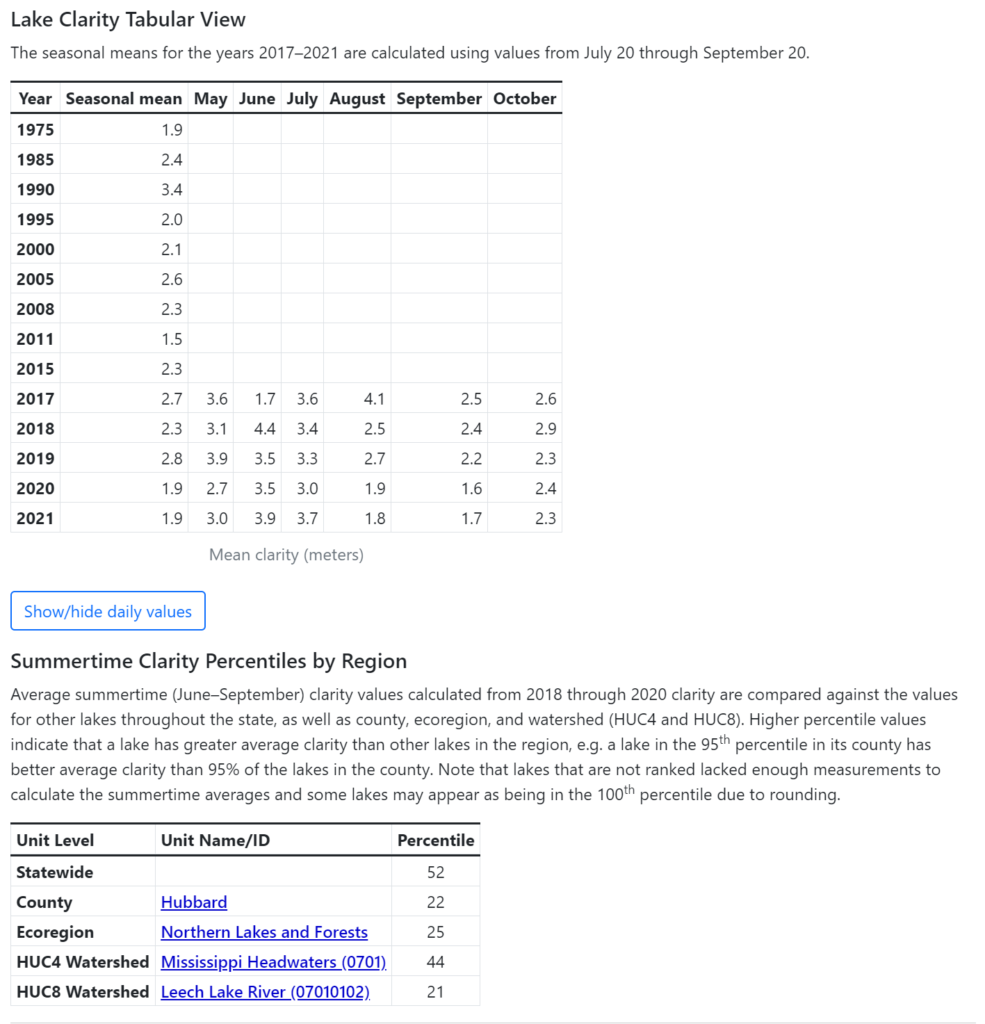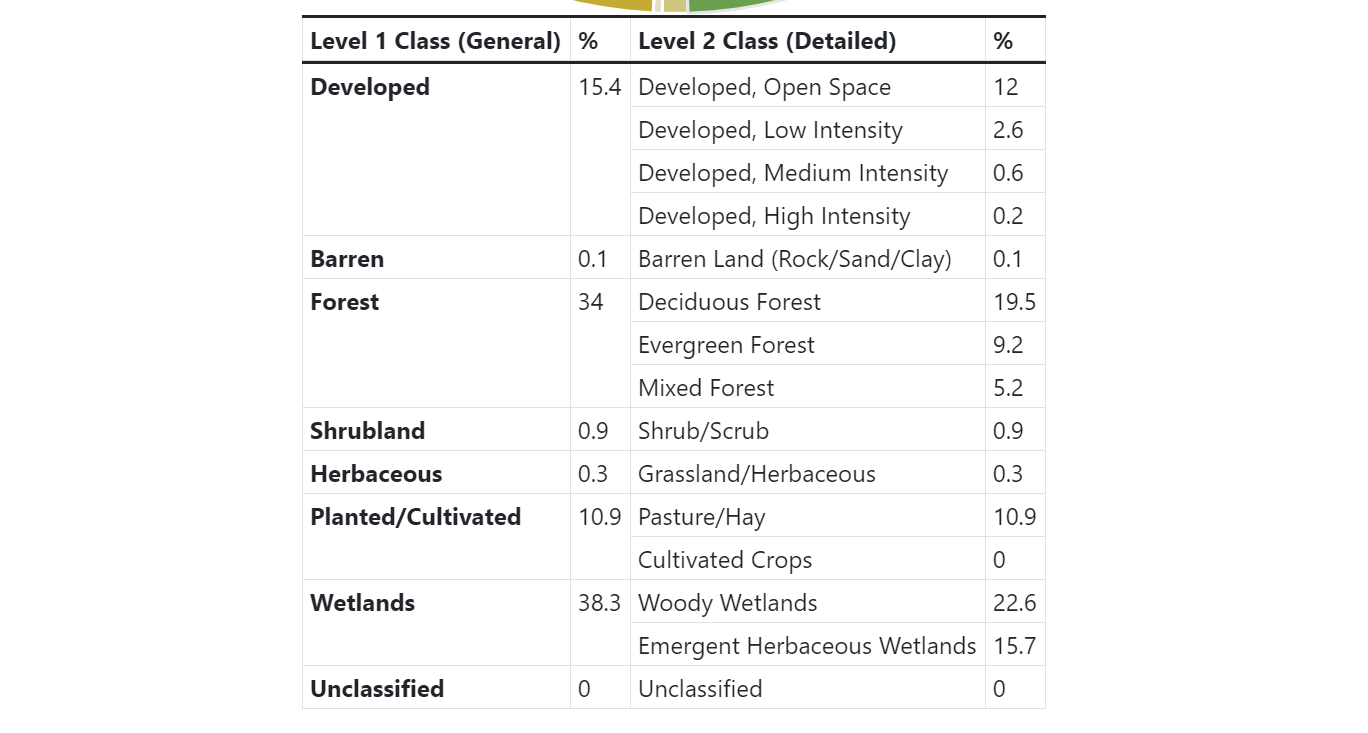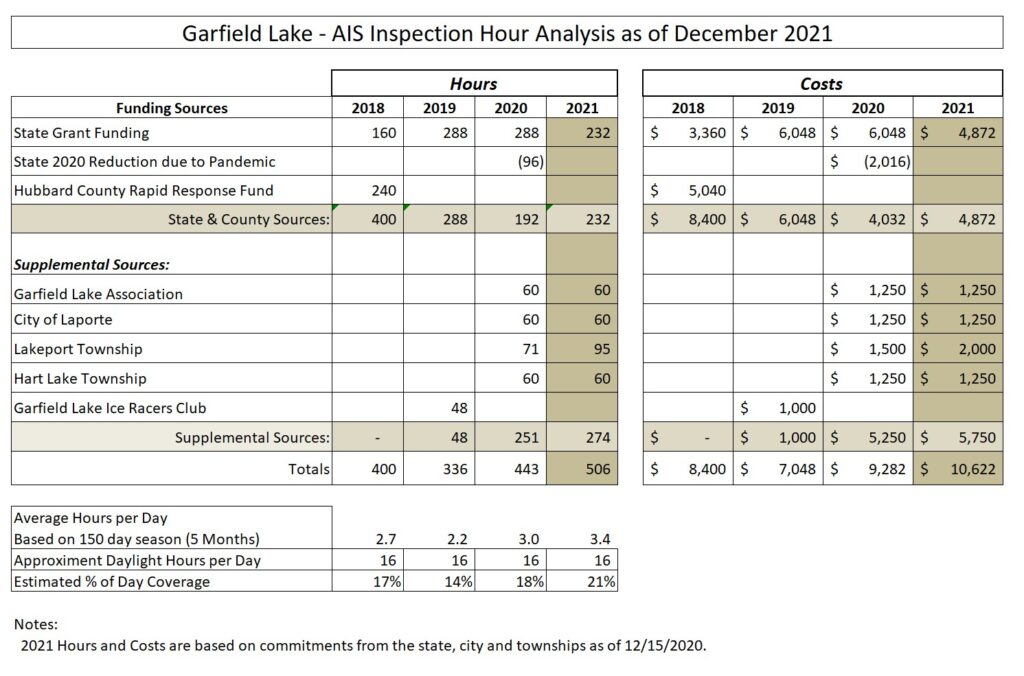The water clarity history is available on the Minnesota DNR Lake Finder website and the University of Minnesota Lake Browser for Garfield Lake. The current report is show in the images below:






Information about Aquatic Invasive Species and Water Quality
The water clarity history is available on the Minnesota DNR Lake Finder website and the University of Minnesota Lake Browser for Garfield Lake. The current report is show in the images below:





Garfield Lake Residents,
We had a bit of good news over the last week or so, regarding Garfield Lake. We had RMB Labs do a vegetation survey in an area of about 100+ yards around the boat landing looking specifically for any signs of zebra mussel or any AIS vegetation concerns. They ( 2 employees of RMB) spent about 1 ½ hours in a boat “raking weeds from the bottom” and looked in detail at what they found. Their findings showed nothing of concern! Great news !!
They will be putting this data together in some organized form showing what they found ; where (the specific spot) and how much. We will share this with you guys when we get it but we wanted to pass on this good news now. Greg, Mark and I were able to see how they did this. We have some photos we took which we will pass on.ww.facebook.com/garfieldlakeassociation/
Dan Fitch
President
Garfield Lake Association
This is an update of the 2021 Boat Landing AIS Inspection program for Garfield Lake based on the latest updates from all participating entities.
We have recently received notification from the Hubbard County Environmental Specialist, Nick Macklem, who administers the Hubbard County Aquatic Invasive Species (AIS) Program. He has received the state funding for the 2021 program and allocated it the participating lakes. The detailed information can be found on his link to the Hubbard County AIS Webpage.
During this past year, the following entities have continued to partner with the GLA in funding supplemental AIS Inspection hours for our landing:
City of Laporte
Lakeport Township
Hart Lake Township
We appreciate, as lake shore owners, the commitment shown by the surrounding communities who also appreciate the lake.
The 2020 program lost some state contribution mid-year due to budget constraints related to the pandemic, but it still was the largest hours of inspection time we have received since the program began. The 2021 program hours exceed this past year. The following chart summarizes the funding of the program since inception including this coming year:

The contributions for supplemental funding are generally made in January, this years deadline is January 31, 2021. The GLA will make its’ contribution this month and works with the city and townships to assure they also meet the deadline.
As a reminder, the GLA’s contribution is funded by the fundraising efforts in 2019 and has not been funded by GLA dues. This effort funded 3 years of contributions and more fundraising will be needed for the 2023 program year.
GLA Members: This email was received 11/25/2020 by the GLA and outines and updates us on the Hubbard County AIS Inspection program. Nick Macklem is the AIS Inspection co-ordinater and we work with him on the supplemental funding and staffing of the inspectors at our boat launch.
Good afternoon Hubbard County Lake Associations,
My name is Nick Macklem with the Hubbard County Aquatic Invasive Species (AIS) Program. Now that the ice has started to form bringing a conclusion to the 2020 open-water season, it is time to begin planning for 2021. Next year, Hubbard County will continue our AIS Prevention work through watercraft inspections. A crucial component to our program are the contributions that Lake Associations and Townships so generously provide. In 2020, Hubbard County Lake Associations contributed $108,670 which equated to 5,174 supplemental inspection hours. On behalf of Hubbard County and the AIS Program, a huge thank you! We look to continue this excellent partnership in 2021. Attached to this email is a copy of the 2021 Supplemental Funding Letter to Lake Associations, which is also available at the following link to the Hubbard County AIS Webpage. Information pertaining to the exact number of State funded inspection hours that will be provided by Hubbard County in 2021 will be sent out in the next couple of weeks, but will generally be very similar to the amount of hours provided in 2020 after the COVID-19 related budget alterations.
Please let me know if you have any questions regarding the content of this email. Enjoy your winter, and I look forward to 2021!
Best regards,
Nick Macklem
Environmental Specialist
301 Court Avenue
Park Rapids, MN 56470
Tel: (218) 732-3890
Attachment: AIS Funding letter
This information is from the Hubbard County Coalition of Lake Associations (HC COLA) regarding an annual survey administered by them:
Many thanks to the 135 individuals who completed the 2020 Eyes on the Water Survey. And thanks to everyone who monitored their lakeshores, equipment, accesses and the lake itself for Aquatic Invasive Species (AIS).
While invasives continue to threaten Minnesota’s lakes, Hubbard County lakes are still relatively invasive-free.
As “first responders” you play a key role in locating AIS on your lake. Early detection has proven to be an effective way of stemming the subsequent spread of AIS to other lakes.
The following new infestations were detected in 2020:
Long Lake – zebra mussels
Big Mantrap – eurasion water milfoil
Boulder – faucet snails
Summary information from the survey has been tabulated and can be found here: http://hubbardcolamn.org/eyes-on-the-water—early-detection.html
Wishing you all a restful and HEALTHY winter,
Jeff Mosner
Hubbard Coalition of Lake Associations
Here is some information on the Trophic State Index which summaries a lake’s nutrient richness.
Trophic State Index as defined by Wikipedia:
The Trophic State Index (TSI) is a classification system designed to rate water bodies based on the amount of biological productivity they sustain.[1] Although the term “trophic index” is commonly applied to lakes, any surface water body may be indexed.
The TSI of a water body is rated on a scale from zero to one hundred.[1] Under the TSI scale, water bodies may be defined as:[1]
The quantities of nitrogen, phosphorus, and other biologically useful nutrients are the primary determinants of a water body’s TSI. Nutrients such as nitrogen and phosphorus tend to be limiting resources in standing water bodies, so increased concentrations tend to result in increased plant growth, followed by corollary increases in subsequent trophic levels.[a] Consequently, trophic index may sometimes be used to make a rough estimate of biological condition of water bodies.[2]
Garfield Lake Data:
Nutrient richness ranges from clear lakes low in nutrients to green lakes with high nutrients . 0 is clear to 90 which is very green
Garfield Lake is at 42
Lakes in the same eco-region range 38-45
Chlorophylla:
Garfield is at 52 parts per billion
Lakes in the same eco-region ranges 44-53
Total phosphorus:
Garfield is at 42
Lakes in the same eco-region ranges 42-52
Lake transparency for Garfield’s trend line is 11-13 feet
Record of lake levels for Garfield 2009 -2018
Lowest September 2013 – 1311.2 feet above sea level
Highest August 2014 – 1312.4 feet above sea level
So the range is 1.2 feet from highest to lowest water level
Even though COVID 19 had us somewhat locked in, it was another great summer on Garfield Lake and seemed like there was a lot of activity on the Lake. The July 4th fireworks were outstanding and the fishing was good for those that know how to catch them.
For the summer of 2020, we had 22 Zebra Mussel Tubes (ZMT) distributed around the lake with 21 respondents that reported there was no evidence of any mussels on the tubes, their docks or boats.
ZMT are a simple section of PVC pipe that we hand from our docks about a foot above the bottom, they are smooth hard surfaces that make it easy to detect zebra mussels as they start to develop and attach to hard surfaces around the lake. This is an early warning system to identify a coming problem.
This is very positive news, but we must continue to practice and educate everyone on the following:
The Board would like to thank all those that have assisted in the monitoring the ZMT’s for 2020 and look forward to 2021 monitoring and remember, if anyone else wants to get involved for next year just sent me an email at ceclark49@icloud.com and someone will get you a ZMT.
Have a Great and Safe winter.
Charlie Clark
ZMT Coordinator

Hello GLA Members, yesterday we heard back from Sharon Natzel, President of Hubbard County Coalition of Lake Associations (HC COLA) that the second Zebra Mussel Veliger (ZMV) test we did this year ( July 2020) showed the presence of 2 veligers. Bummer. I am sure we are all disappointed as we have gone for the last 3 samples without finding one. As you may recall, we take these water samples at 3 points around Lake Garfield two times a year, June and July. We started this ZMV testing in July 2017, before we were a lake association. As of today, we have still not seen the presence of any adult zebra mussels.
I guess one take away from this is the importance of being diligent in monitoring access to our lake and the importance of the Clean-Drain-Dispose efforts to keep the AIS from spreading.
1. CLEAN all visible aquatic plants from your watercraft, trailers, and water-related equipment before leaving any water access or shore land.
2. DRAIN water-related equipment (boat, ballast tanks, portable bait containers, motor) and drain bilge, live well and baitwell by removing drain plugs before leaving a water access or shoreline property. Keep drain plugs out and water-draining devices open while transporting watercraft.
3. DISPOSE of unwanted bait, including minnows, leeches, and worms, in the trash. It is illegal to release bait into a waterbody or release aquatic animals from one waterbody to another. If you want to keep your bait, you must refill the bait container with bottled or tap water.
If you are interested, click here the actual RMB Lab report that shows the presence of these 2 veligers. It is no big deal but I thought one of our members might be interested in seeing what it says.
As it shows in our GLA By Laws, the mission of the GLA is to “protect and enhance the quality of the lake”. We will continue to work with those who can help us do that for Garfield. If you have any questions regarding this please contact any of the Board members using their emails shown on the GLA website: https://garfieldlakeassociation.com/
Thank you for being a member and supporting Garfield Lake.
Ron Ray, President
Zebra Mussel Veliger Test Results
Garfield Lake 2017 – 2020
RMB Labs Results
June Test July Test
2020 none found 2 veliegers
2019 none found none found
2018 1 veliger 1 veliger
2017 not taken 1 veliger
Good news, this photo isn’t from our lake AND we got the results back the test results for our first of two Zebra Mussel Veliger test we do each summer and NO Veligers were found!
This is definitely good news, but we will continue to test for this. Last year we had negative results both tests as well (No Veligers). The DNR has told us that we will need 5 years of negative tests before they would consider de-listing our lake.